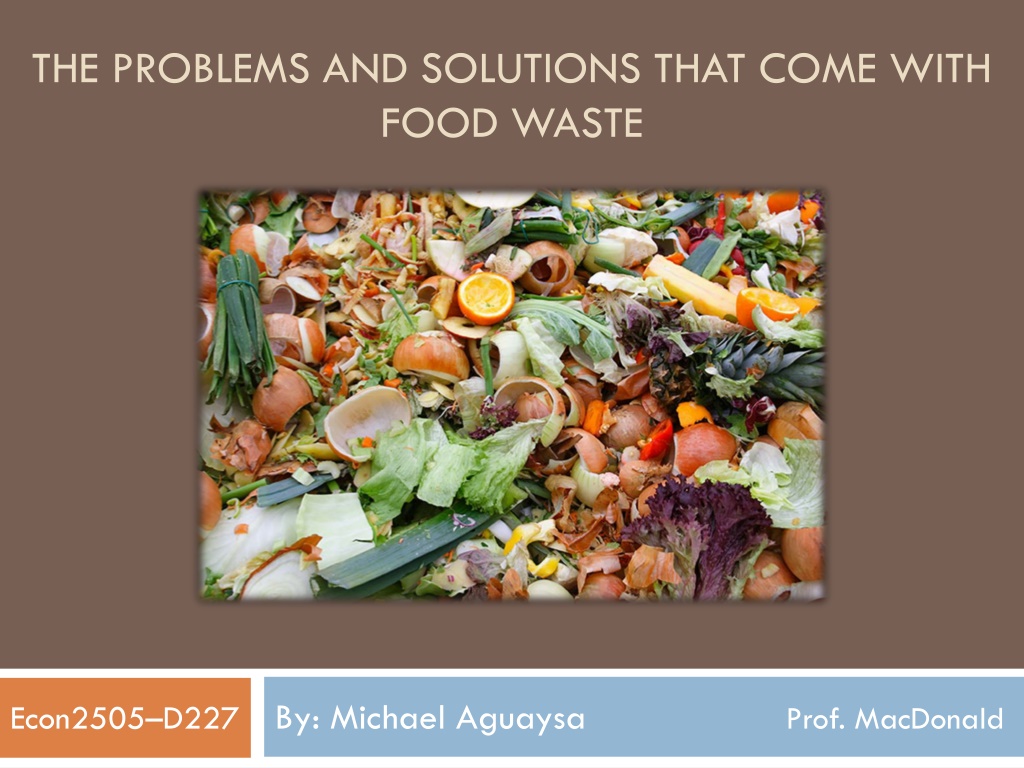The Impact of Food Waste: Problems and Solutions
Food waste is a significant issue globally, with approximately one third of food produced being wasted. This waste not only affects resources and sustainability but also contributes to greenhouse gas emissions. Through examples like Real Madrid Restaurant, it's evident that managing food orders efficiently can help reduce waste and combat environmental damage caused by landfills. By addressing this problem at individual and industry levels, we can make strides towards a more sustainable food system.
Download Presentation

Please find below an Image/Link to download the presentation.
The content on the website is provided AS IS for your information and personal use only. It may not be sold, licensed, or shared on other websites without obtaining consent from the author. Download presentation by click this link. If you encounter any issues during the download, it is possible that the publisher has removed the file from their server.
E N D
Presentation Transcript
THE PROBLEMS AND SOLUTIONS THAT COME WITH FOOD WASTE By: Michael Aguaysa Econ2505 D227 Prof. MacDonald
What exactly is Food Waste? It s not necessarily only food consumption entirely but how it gets lost in the food system. The food system includes problems in our natural resources, globalization, food insecurity, and land availability. The world needs to cut food waste because according to a United Nations study, about one third of the food on the planet is wasted; that equals to about 1.4 billion tons of food.
Field Research Real Madrid Restaurant Real Madrid Restaurant, located on Staten Island. Specializes in a Spanish Cuisine. Owners: Pepe Ramirez and Manny Rivas.
Field Research Summary We discussed about their business and how the restaurant operates. It is important for them to order enough food to last them the few days until another shipment comes in but not an excessive amount that the food will start to spoil. It was all about calculating the amount of food they order each every other day to have enough until the next order and it varies every single month as the restaurant is not as busy in the Summer as it is in the Winter.
Field Research Summary contd If there is food leftover and about to spoil, what happens? There are times when the customer doesn t want to take their food home and the restaurant is forced to throw it away, even if it is visibly untouched. It would be difficult to donate the rice that is unused or frozen meat about to go bad because it cost money and it is financially better to throw it away than to donate it
Where does thrown away food go? Go to landfills that fill up with sometimes edible, good fruits or vegetables. One problem is that these landfills create Methane. Methane, a potent greenhouse gas with 21 times the global warming potential of carbon dioxide manifests in our landfills as a result of decomposition. (Spoiled Food Archives.) If we can limit the amount of food going to these landfills, we can limit the amount of Methane in the air.
Graph depicts specific types of food consumed and lost due to waste. Jancer, M., & Peek, K. (2014).
Common Misconceptions People assume that the Use by or Sell by date is when the food is inedible but that s not true. It is just an estimate to when the food will probably be spoiled. It is estimated that 630,000 tones of freezable food, worth up to 2.3 billion, are thrown away by UK consumers each year due to having passed labeled use by dates. (Jancer, M., & Peek, K. )
We can we do? Another easy solution anyone can do is to lower the temperature of your fridge by five degrees to increase the products shelf life. Freeze your food, including fruits and vegetables. (You can make a smoothie). Avoid ordering too much food in restaurants or buffets to avoid waste. Don t be afraid to pick out fruits or vegetables that may not look so appealing or only a single item left.
This data depicts how much specific regions consume and lose. China, Japan, and South Korea consume and waste food the most The U.S. rank in 6th in this chart. Jancer, M., & Peek, K. (2014).
Conclusion By understanding the shelf life of food, everyone can have an idea of when things start to go bad to avoid it going in the trash. We can planning when you are going to cook your food when you first buy food is important to avoid spoilage. Businesses have ways to prevent food waste by calculating shelf life on their products. I believe some of the information and research here can help people become more aware of things they are doing without being aware they are contributing to food waste.
Resources [LastWeekTonight]. (2015, July 19). Last Week Tonight with John Oliver: Food Waste (HBO) [Video File]. Retrieved from https://www.youtube.com/watch?v=i8xwLWb0lLY. Jancer, M., & Peek, K. (2014). How the World Wastes Food. Popular Science, 285(3), 34-35. Brown T, Hipps N, Easteal S, Parry A, Evans J. Reducing domestic food waste by lowering home refrigerator temperatures.International Journal Of Refrigeration [serial online]. April 2014;40:246-253. Available from: Academic Search Complete, Ipswich, MA. Camire, M. E. (2015). Resolve to Reduce Food Waste. Food Technology, 69(1), 7. O'Donnell, T., Dentsch, J., Pepino, R., Millron, B. J., Yungmann, C., & Katz, S. H. (2015). New Solutions For Food Loss And Waste Prevention. Biocycle, 56(11), 34-38. Mavrakis, V., Thompson, K., Coveney, J., & Ward, P. (2015). Food Waste. In K. Albala (Ed.), The SAGE Encyclopedia of Food Issues(Vol. 2, pp. 642-648). Los Angeles: SAGE Reference. Retrieved April 1, 2016, from Gale Virtual Reference Library. "Spoiled Food Archives - Reduce ~ Reuse ~ Recycle ~ Live." Reduce Reuse Recycle Live. N.p., n.d. Web. 12 May 2016.

 undefined
undefined





























